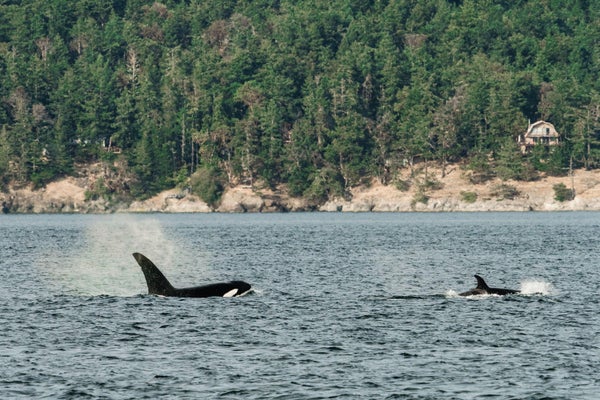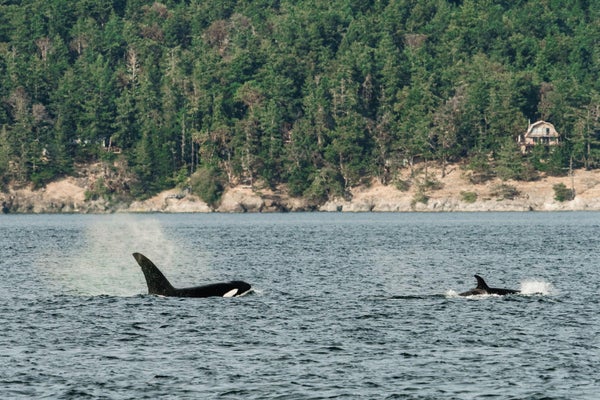
[ad_1]
Orca Groups with Radically Different Cultures Are Actually Separate Species
“Resident” and “transient” killer whales, or orcas, have unique hunting habits and genetics, proving they are in fact separate species

Wide view of two Bigg’s Killer Whales in Washington State.
Cavan Images/Alamy Stock Photo
Two populations of killer whales off the Pacific Northwest coast have clear, major differences in culture: one group hunts down and kills large marine mammals in aggressive coordinated attacks, while the other are relatively docile salmon eaters. Scientists have long wondered whether these two are unique populations of one species (Orcinus orca) or represent subspecies or fully separate species. Now genetic data from a study published March 27 in Royal Society Open Science show these killer whale groups are indeed two distinct species. And there could be more.
One of the Pacific Northwest groups is known as the “residents” because its members live near shore and feed on salmon. The other, called the “transients” (or sometimes Bigg’s killer whales) live farther out in the open ocean and eat hefty mammals, including seals, dolphins and juvenile whales. The groups avoid each other and are rarely seen interacting despite being in the same general area; scientists have long attributed this to a deep cultural divide.
The two populations of killer whales, also known as orcas, have vastly different behaviors and lifestyles. Residents, for example, form large family groups, or pods, of closely related individuals that number up to 20 or more. Pods occasionally intermingle, and such gatherings can be magnificent to watch. The late researcher Ken Balcomb wrote about making a foggy trip into Washington State’s Puget Sound with his colleagues for orca research when three resident pods—more than 80 animals in all—gathered around the scientists’ boat and swam beside it for two hours until the fog lifted. “Did they know that we couldn’t see well enough to navigate from land bearings?” Balcomb wrote in Pacific Discovery. “Were they guiding us?”
On supporting science journalism
If you’re enjoying this article, consider supporting our award-winning journalism by subscribing. By purchasing a subscription you are helping to ensure the future of impactful stories about the discoveries and ideas shaping our world today.
Experts would never expect this kind of behavior among the transients, which form much smaller pods and coordinate to strategically take down big prey mammals. Josh McInnes, a graduate student and research scientist at the University of British Columbia, who wasn’t involved with the new study, recounts how he and his colleagues watched as a transient pod approached a large cluster of sea lions off Moss Landing, Calif., a couple of years ago. The killer whales dove down and disappeared. “Out of nowhere, we saw the water explode,” McInnes says. He describes the hunters relentlessly battering a large male sea lion with their heads and dorsal fins until he succumbed—then turning immediately to their next victim. (Observations of such hunts are detailed in a study led by McInnes that was published on March 20 in PLOS ONE.)
Besides cultural differences, the two groups have a few anatomical tells: Residents have a more rounded dorsal fin that curves toward the tail, but transients’ fin is more pointed and straight, says the new study’s co-author Tom Jefferson, a National Oceanic and Atmospheric Administration marine mammal biologist. The whitish “saddle patch” marking orcas are known for also extends farther forward on transients and is solid, or “closed.” In residents this marking tends to be “open,” with black coloration within. The two species also have notable differences in the dimensions of their skull and the shape of their teeth.
The new research weaves together evidence from dozens of recent studies and includes genetic analyses that confirm that the groups are not just unique populations or subspecies but entirely separate species—and that they have been so for a long time. They likely diverged genetically between 300,000 and 200,000 years ago. Newly developed tests based on these genetic analyses can “tell with 100 percent certainty whether [an orca is] a resident or transient,” says lead author Phillip Morin, a geneticist who studies killer whales at the Southwest Fisheries Science Center (part of NOAA) in La Jolla, Calif.
The new study found no evidence of gene flow between the residents and transients. “There is no interbreeding,” Morin says. “They could, based on their proximity, but they don’t.”
The researchers have proposed that residents be called Orcinus ater and that transients be labeled Orcinus rectipinnus. The proposed names will soon be reviewed by the taxonomic committee of the Society for Marine Mammalogy, Jefferson says. If approved, they’ll become the accepted scientific names for the animals from now on.
There are several other groups of killer whales in the Pacific Ocean, and this study helps lay the foundation for figuring out exactly how they are related to one another, McInnes says. Besides transients and residents, there are also the “oceanics”—a little-understood group living well offshore in very deep waters, he says. This group is described in another study that was co-authored by McInnes and published this month in Aquatic Mammals. It includes sightings of 49 individual animals from 1997 to 2021. McInnes and his colleagues suggest this group may be a subpopulation of transients, but there are no genetic data yet to verify this.
Knowing the residents and transients are unique species is “incredibly important from a conservation standpoint,” says Ally Rice, a research associate at the Scripps Institution of Oceanography, who wasn’t involved in the Morin study. “It’s challenging to create effective conservation policies for a globally distributed species like the killer whale because animals in different regions of the world are all facing different threats.” Policies designed to conserve killer whales in general will never be as helpful as those designed to help protect, for example, the endangered fish-eating southern resident killer whale population.
[ad_2]